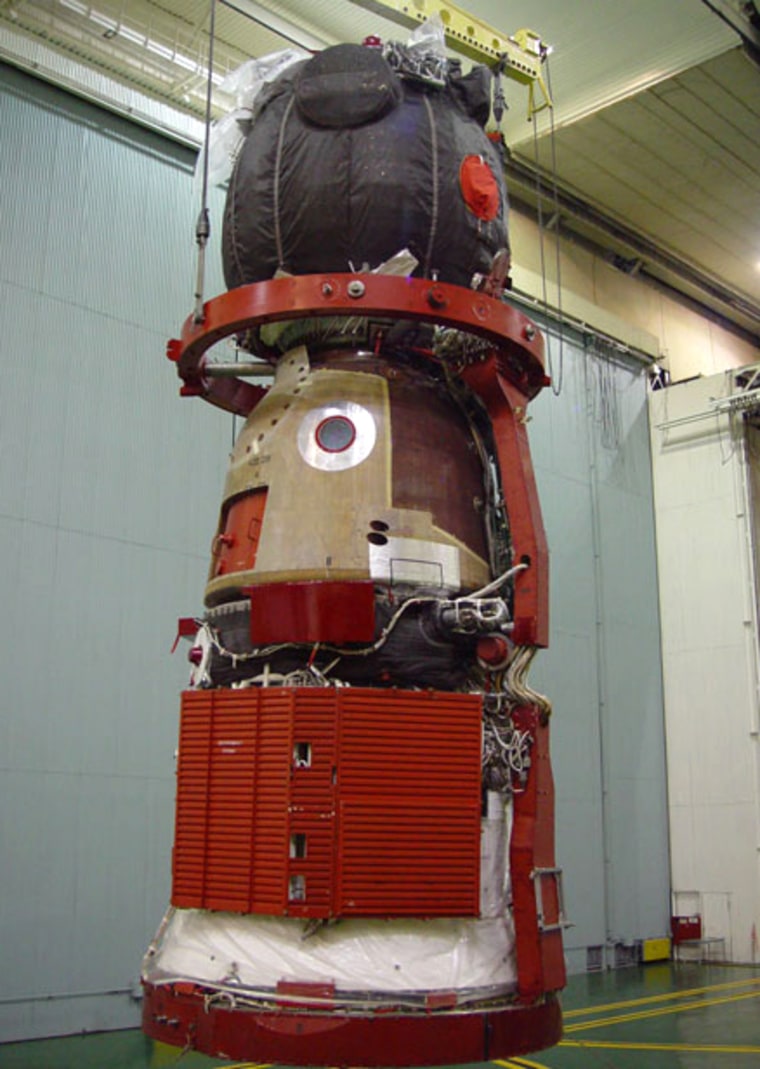The explosion of a small separation bolt aboard the Soyuz spaceship now being prepared for a trip to the international space station may delay that launch for five or 10 days, Russian space officials have told journalists in Moscow. But so far, Russia has not officially informed its American partners of any possible delay.
A NASA official told MSNBC.com on condition of anonymity that rumors of a possible delay were “heard in the halls” on Tuesday, but by the end of the day the gossip was that no schedule impact was expected.
Aboard the space station, Russian cosmonaut Gennady Padalka and NASA astronaut Michael Fincke are in the last month of their six-month orbital mission, the ninth expedition to the station. They are due to be replaced by cosmonaut Salizhan Sharipov and astronaut Leroy Chiao, who were scheduled to blast off on Oct. 9. They will stay in space for at least six months, and rumors persist that one or both of them may be required to remain there significantly longer.
Shifting reports
Initial reports from Russia's Federal Space Agency in Moscow referred to a potential Soyuz launch delay due to technical problems with the docking system. This was the report initially carried by Western news agencies and was the rumor circulating within NASA as well.
But within hours, the Itar-Tass news agency was quoting veteran spacecraft engineer Vladimir Syromyatnikov as giving the reason for a possible postponement as “the sudden explosion” of a “fuse bolt” inside the spacecraft. This apparently refers to the small explosive bolts that sever mechanical and electrical connections between sections of the Soyuz during landing.
“It takes a lot of work to reach it," he explained, referring to the significant disassembly that must be done to reach the bolt, inspect the area for damage, and replace it. Such bolts generally are self-contained and do not inflict damage on surrounding structure. The force of the explosion is unknown, and NASA press representatives did not have data on the size of these explosive charges.
Syromyatnikov is a senior manager at the Russian rocket company Energia in Moscow, where he is head of the Department of Electromechanics and Large-Size Space Structures. He has worked on Russia's piloted space vehicles for 40 years, and was co-inventor of the androgynous docking mechanism first used by the Apollo-Soyuz mission in the 1970s and now standard for all U.S., Russian and Chinese piloted space vehicles.
He explained that the bolt fired during repetitive power testing of the Soyuz vehicle at the launch site. The bolts typically have the force of commercial fireworks, such as a large cherry bomb. Detonation during ground testing is highly unusual.
Explosive concerns
If the explosion was triggered when faulty ground equipment sent too large a surge into the circuit, the impact of the incident on other systems should be minimal. But if the accidental firing was the result of a flaw in the bolt, all other such bolts on the spacecraft may have to be verified.
And if bolts from the same batch are also installed on the Soyuz currently docked to the space station, a significant effort will be required to requalify them or to develop contingency plans if one or more of them misfire on the planned return to Earth, now scheduled for Oct. 19 Moscow time.
Failures of such explosive bolts are rare but not unprecedented. In 1969, the failure of the separation system on the Soyuz 5 spacecraft led to it entering Earth’s atmosphere with the crew-carrying command module still loosely attached to the equipment-carrying service module. Off balance, the spacecraft turned its unprotected side into the super-hot plasma and began burning, but the G-force stresses soon tore the two sections apart, and the capsule righted itself barely in time.
Fighting the calendar
Vyacheslav Davidenko, a spokesman for the Russian space agency, told Itar-Tass that all efforts were being made to stick to the current launch schedule. "A special commission was created in Baikonur, which will check the functioning of all the systems of the spaceship and will remove the defects as soon as possible," he said.
"The safety of the crew is the most important thing for us,” he continued. “Nevertheless, we set ourselves the task of preparing the spaceship for launching before Oct. 9, which is a planned date."
Delaying the launch would also delay the landing of the current station crew, and this would lead to mounting safety issues. The Soyuz spacecraft has a certified lifetime of about six and a half months in space, and beyond that point, high-energy chemicals in its propulsion system threaten to become unstable. Other mechanical systems gradually lose reliability as well, but these concerns would take weeks to become significant.
Currently, the return to Earth is planned for 6:22 a.m. Moscow time Oct. 19. This is shortly after sunrise at the landing zone in Kazakhstan. But the continuing shifting of the station’s orbit in space pushes the landing time, on average, about half an hour earlier per day.
Thus, a 10-day delay would force the crew to land hours before sunrise. Russian space recovery forces prefer not to operate in the dark because search-and-rescue teams are much less well-equipped than they were in the heyday of the Soviet space race.
